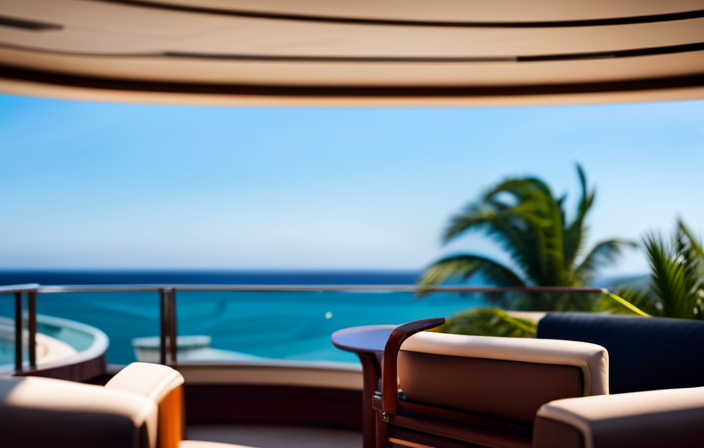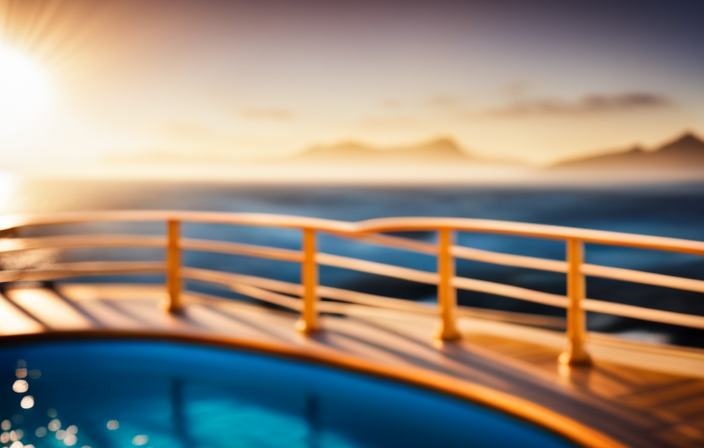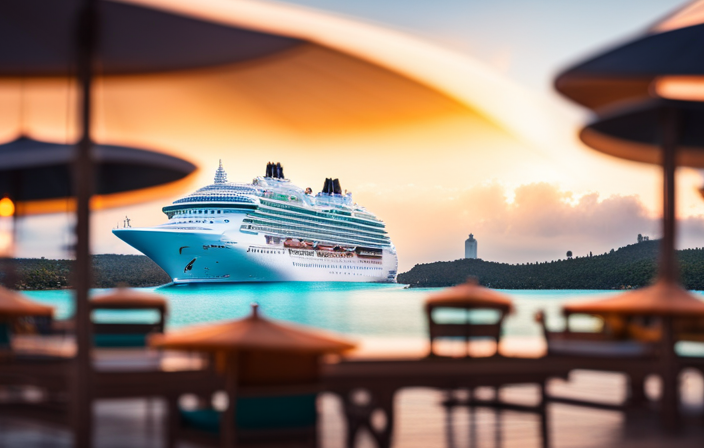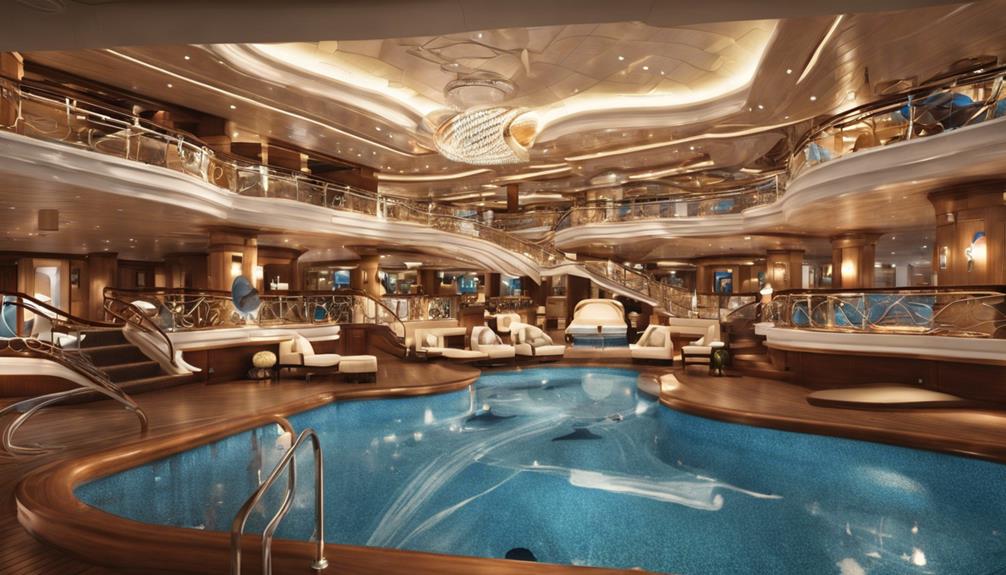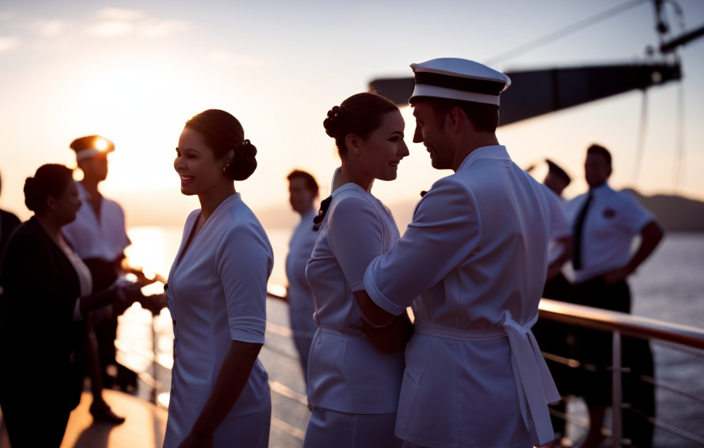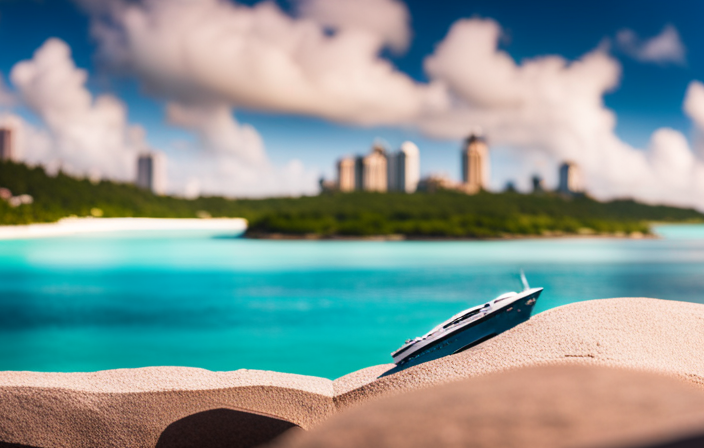I vividly recall my inaugural cruise ship voyage. The thrill of discovering new places, savoring delectable cuisine, and relishing in limitless entertainment was unmistakable. Yet, this initial excitement soon gave way to unease as I began to suffer from seasickness.
The constant swaying of the ship left me feeling queasy and unable to fully enjoy my vacation. It was then that I realized the importance of choosing the right location on a cruise ship to minimize the effects of motion sickness.
In this article, I will explore various strategies and tips to help you find the best place on a cruise ship for motion sickness. From midship on lower decks to cabins equipped with stabilizers, we will delve into the options that can provide a smoother sailing experience.
So, if you’re prone to seasickness like me, keep reading to discover how to make your next cruise a more enjoyable and nausea-free adventure.
Key Takeaways
- Midship on lower decks is the best location for minimizing motion sickness.
- Inside cabins and balcony cabins on lower decks provide stability and reduce motion sickness.
- Stabilizer-equipped ships offer a smoother sailing experience and can help alleviate motion sickness.
- Avoiding the forward and aft sections of the ship can help prevent motion sickness.
Midship on Lower Decks
If you want to minimize your chances of experiencing motion sickness on a cruise ship, the best place for you to be is midship on the lower decks. This midship location is known for having the least amount of movement due to its position in the center of the ship.
By staying in this area, you can help avoid the rocking and swaying that can often lead to seasickness. Additionally, being on the lower decks can provide more stability as they are closer to the ship’s center of gravity.
To further prevent motion sickness, there are seasickness remedies available such as over-the-counter medications and wristbands that apply pressure to certain points on the body. These remedies can help alleviate symptoms and make your cruise experience more enjoyable.
Moving on to the next section about inside cabins, you’ll find that they also offer some benefits in minimizing motion sickness.
Inside Cabins
You’ll never believe it, but the most sought-after spot on a cruise ship for avoiding those queasy feelings is actually tucked away in the cozy, windowless cabins. While it may seem counterintuitive, staying in an inside cabin can be an effective remedy for motion sickness.
These cabins are typically located in the middle of the ship, where the movement is least felt. Being away from windows also eliminates visual cues that can trigger nausea. Additionally, inside cabins tend to be more affordable, making them a popular choice for budget-conscious travelers.
However, if you’re still concerned about motion sickness, there are other effective remedies available, such as over-the-counter medications, acupressure wristbands, and ginger supplements.
Transitioning into the next section, it’s worth mentioning that some cruise ships are equipped with stabilizers, which can further minimize motion and make for a smoother sailing experience.
Stabilizer-equipped Ships
Equipped with stabilizers, these ships gracefully glide through the ocean, ensuring a smoother and more enjoyable sailing experience. Stabilizers are designed to reduce the rolling motion of the ship, which can help alleviate motion sickness symptoms for passengers. These devices work by extending from the sides of the ship and counteracting the forces that cause the ship to roll. While stabilizers are generally effective at reducing motion sickness, it’s important to note that their effectiveness can vary depending on the sea conditions. Alternative remedies, such as over-the-counter medications or natural remedies like ginger, can also be used in conjunction with stabilizer-equipped ships to further minimize the chances of experiencing motion sickness. When it comes to finding the best place on a cruise ship to avoid motion sickness, avoiding the forward and aft sections is another important consideration.
Avoiding Forward and Aft Sections
To avoid feeling like you’re on a roller coaster at sea, it’s best to steer clear of the forward and aft sections of the ship. These areas tend to experience the most motion and are a magnet for seasickness. To prevent this unpleasant sensation, there are several techniques you can try.
First, consider taking over-the-counter medications specifically designed for motion sickness relief. These can be effective in reducing symptoms.
Another option is to wear wristbands that apply pressure to certain acupressure points. Many individuals have found these bands to be helpful in alleviating seasickness symptoms.
If you prefer natural remedies, you can try ginger supplements or herbal remedies that claim to help with motion sickness. These alternative options may provide relief for some people.
Moving on to discussing balcony cabins on lower decks, it’s important to note that these areas provide a more stable experience and decrease the likelihood of motion sickness.
Balcony Cabins on Lower Decks
If you’re looking for a more stable and enjoyable experience, consider opting for a balcony cabin on one of the lower decks. Ocean view accommodations provide a beautiful view of the sea while also offering a sense of tranquility. Here are four reasons why balcony cabins on lower decks can help prevent motion sickness:
-
Lower decks experience less motion: Being closer to the ship’s center of gravity reduces the amount of rocking and swaying you feel, making it easier to maintain your balance.
-
Access to fresh air: Balcony cabins allow you to step outside and breathe in the fresh ocean air, which can help alleviate symptoms of seasickness.
-
Natural light: The abundance of natural light in balcony cabins can help your body adjust to the motion of the ship and minimize feelings of dizziness or nausea.
-
Privacy and relaxation: Having your own private balcony allows you to retreat from the central areas of the ship and find a peaceful space to relax and enjoy the view.
As you transition into the next section about central areas of the ship, you may want to explore other options for those who prefer a more social and lively environment.
Central Areas of the Ship
Get ready to explore the heart of the ship where all the action is happening – the central areas are like a bustling city full of entertainment and excitement! Located in a central location on the ship, these areas are easily accessible and offer a variety of activities to keep you entertained throughout your cruise.
Whether you’re looking to catch a Broadway-style show, try your luck at the casino, or dance the night away at the nightclub, the central areas have it all.
If you’re prone to motion sickness, you may want to consider alternative remedies such as acupressure wristbands or ginger supplements, which can help alleviate symptoms. Additionally, being in the central areas of the ship can provide a more stable experience compared to other parts of the ship.
Now, let’s move on to the next section and look for larger ships that can offer even more stability.
Look for Larger Ships
When considering your options, opting for larger vessels can provide a heightened sense of stability during your cruise experience. Larger ships tend to have more amenities and facilities that can help minimize motion sickness. For example, they often have ocean-facing cabins, allowing you to have a view of the horizon and reducing feelings of nausea.
Additionally, larger ships are equipped with advanced stabilizers and modern technologies that counteract the effects of rough seas. They also have a lower center of gravity, contributing to their stability. Choosing a larger ship increases your chances of having a more comfortable and enjoyable cruise.
Now, let’s explore the benefits of fresh air and natural light on board.
Fresh Air and Natural Light
Breathe in the invigorating ocean air and bask in the warm glow of natural sunlight. These elements on board create a refreshing and rejuvenating ambiance for your cruise experience.
On larger cruise ships, there are ample opportunities for outdoor activities that allow you to fully immerse yourself in the scenic views. Whether it’s jogging on the deck, practicing yoga overlooking the horizon, or simply lounging by the pool, the fresh air and natural light can help alleviate motion sickness symptoms.
Not only does the open air provide a sense of freedom and tranquility, but it also helps distract your senses from the motion of the ship.
So, as you embrace the great outdoors on your cruise, you can transition into the subsequent section about over-the-counter medications and remedies.
Over-the-Counter Medications and Remedies
Take advantage of the convenience of over-the-counter medications and remedies, which can help alleviate any discomfort you may experience while sailing the open seas.
When it comes to natural remedies, ginger has been shown to have anti-nausea properties. You can find ginger in various forms, such as capsules, ginger chews, or even ginger tea.
Another option is acupressure bands, which apply pressure to certain points on your wrists to relieve motion sickness. These bands are easy to use and can be worn throughout the day.
Remember to read the instructions and follow the recommended dosage for any over-the-counter medication or remedy. However, it’s important to consult with a doctor or pharmacist before starting any new treatment, especially if you have any underlying health conditions or are taking other medications. This ensures that you are choosing the best option for your specific needs.
Consult with a Doctor or Pharmacist
Now that we have explored over-the-counter medications and remedies for motion sickness on a cruise ship, it is important to consider consulting with a doctor or pharmacist. These healthcare professionals can provide valuable guidance and expertise to help manage motion sickness symptoms effectively.
Consulting with a doctor or pharmacist offers several advantages. Firstly, they can assess your individual health condition and recommend the most suitable treatment options for you. Additionally, they can provide personalized advice on dosage, potential drug interactions, and any possible side effects.
In addition to medication, doctors and pharmacists can also suggest alternative treatments for motion sickness. These may include natural remedies, such as ginger or acupressure wristbands, which have shown promising results in reducing nausea and vomiting. Consulting with a healthcare professional ensures that you receive the most accurate and up-to-date information on motion sickness management, allowing you to enjoy your cruise without the discomfort of motion sickness.
| Pros of Consulting with a Doctor or Pharmacist | Cons of Consulting with a Doctor or Pharmacist |
|---|---|
| Personalized treatment recommendations | Potential wait times for appointments |
| Expert advice on dosage and drug interactions | Cost of consultation fees |
| Access to alternative treatments | Limited availability of specialists |
Frequently Asked Questions
Are there any specific foods or drinks that can help alleviate motion sickness on a cruise ship?
I found that ginger, specifically ginger tea or ginger candies, can help alleviate motion sickness on a cruise ship. Other home remedies include peppermint and acupressure wristbands.
Is it better to book a cruise during a specific time of year to minimize the chances of experiencing motion sickness?
The best time to book a cruise to minimize motion sickness is during periods of calm seas, which typically occur in the summer months. Seasonal variations can impact the likelihood of experiencing motion sickness on a cruise ship.
Are there any specific activities or areas on the cruise ship that are more likely to trigger motion sickness?
Certain activities on a cruise ship, such as watching cruise ship entertainment or being on outdoor decks, may exacerbate motion sickness. Alternative remedies like aromatherapy or hypnosis can help alleviate symptoms.
Can wearing certain types of clothing or accessories help prevent motion sickness on a cruise ship?
Virtual reality technology can be used to alleviate motion sickness on a cruise ship. It provides a simulated environment that helps distract from the motion. Motion sickness medications can also be effective in preventing seasickness.
Are there any alternative remedies or therapies, such as acupuncture or sea bands, that can be effective in treating motion sickness on a cruise ship?
Acupuncture and sea bands are alternative remedies for motion sickness on a cruise ship. Research suggests acupuncture’s effectiveness, but evidence on sea bands’ efficacy is limited. Consult a healthcare professional for personalized advice.
Conclusion
In conclusion, finding the best place on a cruise ship for motion sickness can greatly enhance your overall experience. By opting for midship cabins on lower decks, you can minimize the impact of any potential swaying. Stabilizer-equipped ships are also a great choice as they help reduce the ship’s motion.
Additionally, avoiding the forward and aft sections, and opting for balcony cabins on lower decks can provide a more stable and enjoyable cruise. Remember to consult with a doctor or pharmacist for over-the-counter remedies and enjoy smooth sailing on your next voyage.
As the saying goes, ‘finding your sea legs’ will ensure a pleasant journey.

